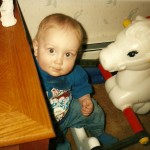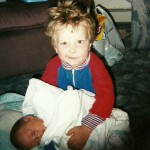safety
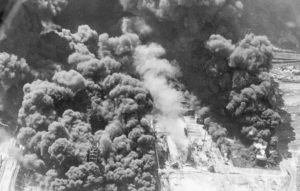 Coal mining, especially underground coal mining can be a dangerous occupation. No matter how hard the safety coordinators tried to keep people safe, and no matter how stringent the safety regulations were, accidents happened and sometimes, lives were lost. Coal mining was especially dangerous when coal dust ignited. Explosions were the main cause of death in the mines,especially the underground mines. And that was just the instantaneous death. Breathing the dust caused a slow death over time. In 1883, the creation of the Norfolk and Western Railway opened a gateway to the untapped coalfields of southwestern West Virginia. New mining towns sprung up in the region practically overnight, with European immigrants and African Americans from the south pouring into southern West Virginia looking for work in the new industry. By the late 19th century, West Virginia was a national leader in the production of coal,but the state fell far behind other major coal-producing states in regulating the mining conditions. In addition to poor economic conditions, West Virginia had a higher mine death rate than any other state. Nationwide, a total of 3,242 Americans were killed in mine accidents in 1907, but no one accident could compare to the accident that was about to unfold as the year neared its end. No on was prepared for the horror that was to come in Monongah in December.
Coal mining, especially underground coal mining can be a dangerous occupation. No matter how hard the safety coordinators tried to keep people safe, and no matter how stringent the safety regulations were, accidents happened and sometimes, lives were lost. Coal mining was especially dangerous when coal dust ignited. Explosions were the main cause of death in the mines,especially the underground mines. And that was just the instantaneous death. Breathing the dust caused a slow death over time. In 1883, the creation of the Norfolk and Western Railway opened a gateway to the untapped coalfields of southwestern West Virginia. New mining towns sprung up in the region practically overnight, with European immigrants and African Americans from the south pouring into southern West Virginia looking for work in the new industry. By the late 19th century, West Virginia was a national leader in the production of coal,but the state fell far behind other major coal-producing states in regulating the mining conditions. In addition to poor economic conditions, West Virginia had a higher mine death rate than any other state. Nationwide, a total of 3,242 Americans were killed in mine accidents in 1907, but no one accident could compare to the accident that was about to unfold as the year neared its end. No on was prepared for the horror that was to come in Monongah in December.
The worst mining accident in United States occurred on December 6, 1907. The mine was the Monongah Coal 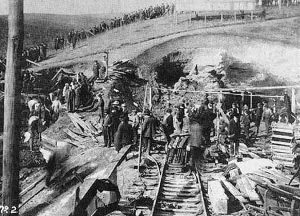 Mine in West Virginia’s Marion County. on that date, an explosion in a network of mines owned by the Fairmont Coal Company in Monongah killed 362 coal miners. Officially, there were 367 men in the two mines, but the actual number was much higher because officially registered workers often took their children and other relatives into the mine to help. No one thought of the practice as dangerous. At 10:28am an explosion occurred that killed most of the men inside the mine instantly. The blast went on to cause considerable damage to both the mine and the surface. The ventilation systems, necessary to keep fresh air supplied to the mine, were destroyed along with many rail cars and other equipment. The explosion blew the timbers supporting the roof down causing further issues when the roof collapsed. Investigators believed that an electrical spark or one of the miners’ open flame lamps ignited coal dust or methane gas, but the cause of the explosion was not determined.
Mine in West Virginia’s Marion County. on that date, an explosion in a network of mines owned by the Fairmont Coal Company in Monongah killed 362 coal miners. Officially, there were 367 men in the two mines, but the actual number was much higher because officially registered workers often took their children and other relatives into the mine to help. No one thought of the practice as dangerous. At 10:28am an explosion occurred that killed most of the men inside the mine instantly. The blast went on to cause considerable damage to both the mine and the surface. The ventilation systems, necessary to keep fresh air supplied to the mine, were destroyed along with many rail cars and other equipment. The explosion blew the timbers supporting the roof down causing further issues when the roof collapsed. Investigators believed that an electrical spark or one of the miners’ open flame lamps ignited coal dust or methane gas, but the cause of the explosion was not determined.
Time was of the essence to bring people out of a mine accident alive, because at that time they didn’t know much about restoring the air supply to the people trapped below. The first volunteer rescuers entered the two mines 25 minutes after the initial explosion. The biggest threats to rescuers are the various fumes, particularly “blackdamp”, a mix of carbon dioxide and nitrogen that contains no oxygen, and “whitedamp”, which is carbon monoxide. The lack of breathing apparatus at the time made venturing into these areas impossible. Rescuers could only stay in the mine for 15 minutes at a time. In a vain effort to protect themselves, some of the miners 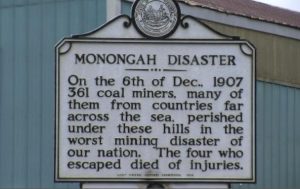 tried to cover their faces with jackets or other pieces of cloth. While this may filter out particulate matter, it would not protect the miners in an oxygen-free environment. The toxic fume problems were compounded by the infrastructural damage caused by the initial explosion…mines require large ventilation fans to prevent toxic gas buildup, and the explosion at Monongah had destroyed all of the ventilation equipment. The inability to clear the mine of gases transformed the rescue effort into a recovery effort. One Polish miner was rescued and four Italian miners escaped. Following the accident, the United Mine Workers of America labor union and sympathetic legislators forced safety regulations that brought a steady decline in death rates in West Virginia and elsewhere.
tried to cover their faces with jackets or other pieces of cloth. While this may filter out particulate matter, it would not protect the miners in an oxygen-free environment. The toxic fume problems were compounded by the infrastructural damage caused by the initial explosion…mines require large ventilation fans to prevent toxic gas buildup, and the explosion at Monongah had destroyed all of the ventilation equipment. The inability to clear the mine of gases transformed the rescue effort into a recovery effort. One Polish miner was rescued and four Italian miners escaped. Following the accident, the United Mine Workers of America labor union and sympathetic legislators forced safety regulations that brought a steady decline in death rates in West Virginia and elsewhere.
 As automobiles became commonplace…or at least more so than they had been, people began to realize that there needed to be some controls on their usage…specially in the area of speed. Most people know that is a car or other vehicle can go fast, there will always be someone out there, who wants to push the envelope and see just how fast it will go, throwing caution to the wind. With increased speeds would also follow, increased numbers of accidents. There would need to be some rules to follow.
As automobiles became commonplace…or at least more so than they had been, people began to realize that there needed to be some controls on their usage…specially in the area of speed. Most people know that is a car or other vehicle can go fast, there will always be someone out there, who wants to push the envelope and see just how fast it will go, throwing caution to the wind. With increased speeds would also follow, increased numbers of accidents. There would need to be some rules to follow.
There were already speed limits in the United States for non-motorized vehicles. In 1652, the colony of New Amsterdam, which is now New York, issued a decree stating that “[N]o wagons, carts or sleighs shall be run, rode or driven at a gallop” at the risk of incurring a fine starting at “two pounds Flemish,” or about $150 in today’s currency. In 1899, the New York City cabdriver Jacob German was arrested for driving his electric taxi at 12 miles per hour, but did the prior law really apply electric cars? It was becoming more and more obvious that some sort of legislation was necessary to ensure the safety of those operating these new machines, and those around them. So began the path to Connecticut’s 1901 speed limit legislation. Representative Robert Woodruff submitted a  bill to the State General Assembly proposing a motor-vehicles speed limit of 8 miles per hour within city limits and 12 miles per hour outside. While the law passed in May of 1901 specified higher speed limits, it required drivers to slow down upon approaching or passing horse-drawn vehicles, and come to a complete stop if necessary to avoid scaring the animals. I can’t imagine some of the restrictions listed there, because people would be stopped more than they were driving, but you have to start somewhere, and Connecticut was that starting point, when, on May 21, 1901 it became the first state to pass a law regulating motor vehicles, limiting their speed to 12 miles per hour in cities and 15 miles per hour on country roads.
bill to the State General Assembly proposing a motor-vehicles speed limit of 8 miles per hour within city limits and 12 miles per hour outside. While the law passed in May of 1901 specified higher speed limits, it required drivers to slow down upon approaching or passing horse-drawn vehicles, and come to a complete stop if necessary to avoid scaring the animals. I can’t imagine some of the restrictions listed there, because people would be stopped more than they were driving, but you have to start somewhere, and Connecticut was that starting point, when, on May 21, 1901 it became the first state to pass a law regulating motor vehicles, limiting their speed to 12 miles per hour in cities and 15 miles per hour on country roads.
Immediately following this landmark legislation, New York City went to work to keep up, and introduced the world’s first comprehensive traffic code in 1903. Adoption of speed regulations and other traffic codes was a slow and uneven process across the nation, however. As late as 1930, a dozen states had no speed limit, while 28 states did not even require a driver’s license to operate a motor vehicle. Rising fuel prices contributed to the lowering of speed limits in several states in the early 1970s, and in January 1974 President Richard Nixon 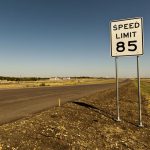 signed a national speed limit of 55 miles per hour into law. These measures led to a welcome reduction in the nation’s traffic fatality rate, which dropped from 4.28 per million miles of travel in 1972 to 3.33 in 1974 and a low of 2.73 in 1983.
signed a national speed limit of 55 miles per hour into law. These measures led to a welcome reduction in the nation’s traffic fatality rate, which dropped from 4.28 per million miles of travel in 1972 to 3.33 in 1974 and a low of 2.73 in 1983.
Concerns about fuel availability and cost later subsided, and in 1987 Congress allowed states to increase speed limits on rural interstates to 65 mph. The National Highway System Designation Act of 1995 repealed the maximum speed limit. This returned control of setting speed limits to the states, many of which soon raised the limits to 70 mph and higher on a portion of their roads, including rural and urban interstates and limited access roads.
 In a time when our nation is in such turmoil, I find myself appreciating our veterans even more than I did before. As a proud daughter of a World War II veteran, I always had a feeling of awe when it came to the members of our military. I never thought of a soldier without associating it with a hero, because that is what they are…each and every one of them. It takes the heart of a hero to set aside their own life, time with family, and their safety to protect the rights and lives of others…people they don’t know…who aren’t in their own country.
In a time when our nation is in such turmoil, I find myself appreciating our veterans even more than I did before. As a proud daughter of a World War II veteran, I always had a feeling of awe when it came to the members of our military. I never thought of a soldier without associating it with a hero, because that is what they are…each and every one of them. It takes the heart of a hero to set aside their own life, time with family, and their safety to protect the rights and lives of others…people they don’t know…who aren’t in their own country.
Soldiers are a special kind of hero. Like our first responders, they run into danger while others are running away, but a soldier does that in countries that aren’t their own. They have no stake in that country, but they know that without their help, the people of that nation are going to continue to live oppressed. The soldier fights for those who cannot fight for themselves. Evil dictators cringe when the soldiers are sent in, because there is a good possibility that the dictator’s days are numbered. War is never an easy journey for the soldier, but he or she knows that they are needed. They know that for every enemy death…a life is saved, and while that may be putting things a little bit simplistically, in a very real sense, it is true. In a war, the enemy must be beaten, in order to win the war, and thereby save the innocent.
Going off to war changes a person, and so does training to go to war. The minute a soldier joins up, there is a possibility of going to war, and the soldier has to face that fact. That’s where the heart of the hero kicks in. Deep down inside, the soldier has knows that what they are doing is important…it matters. Theirs is often a thankless job, and is sometimes treated with great disrespect, but when they are needed, they answer the call, nevertheless. It is our soldiers and their strength, that usually keeps our homeland free from attack. It’s not that we have never had attacks on our soil, but a strong, at the ready military force, makes our enemies think twice about trying to attack us here…and for that, I thank our military men and women. Our nation is very blessed to have our soldiers. To our active duty soldiers and our veterans of all wars, Happy Veterans Day!!
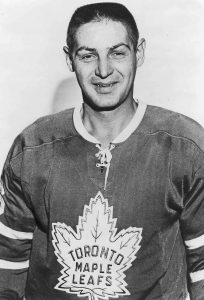
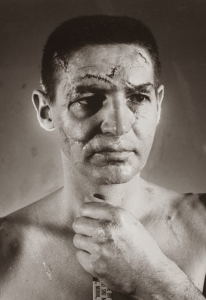 If you could see all of Terry Sawchuk’s wounds at once, his face would look like this one that was reproduced with makeup. In reality, Terry’s wounds have healed over the years, and the scars are not nearly as visible as the makeup reproduction portrays. Nevertheless, Sawchuk’s 16 years of playing goalie for the Toronto Maple Leafs hockey team in the years before the goalies wore safety equipment left their marks and took their toll on his body. Re-created here, by a professional make-up artist and a doctor, are some of the more than 400 stitches he had earned during 16 years in the National Hockey League. Terry Sawchuk’s face was bashed over and over, but not all at one time. The re-creation of his injuries was done to help show the extent of his injuries over a span of years. Sawchuk had sustained other injuries that were not shown here too…a slashed eyeball requiring three stitches, a 70% loss of function in his right arm because 60 bone chips were removed from his elbow, and a permanent “sway-back” that was caused by a continual bent-over posture during the games.
If you could see all of Terry Sawchuk’s wounds at once, his face would look like this one that was reproduced with makeup. In reality, Terry’s wounds have healed over the years, and the scars are not nearly as visible as the makeup reproduction portrays. Nevertheless, Sawchuk’s 16 years of playing goalie for the Toronto Maple Leafs hockey team in the years before the goalies wore safety equipment left their marks and took their toll on his body. Re-created here, by a professional make-up artist and a doctor, are some of the more than 400 stitches he had earned during 16 years in the National Hockey League. Terry Sawchuk’s face was bashed over and over, but not all at one time. The re-creation of his injuries was done to help show the extent of his injuries over a span of years. Sawchuk had sustained other injuries that were not shown here too…a slashed eyeball requiring three stitches, a 70% loss of function in his right arm because 60 bone chips were removed from his elbow, and a permanent “sway-back” that was caused by a continual bent-over posture during the games.
Many people were hurt playing sports in the years before safety equipment was used. For some of them, like Sawchuk, the equipment would not come in time to spare them from years of pain, and even disabilities. It was  a sad reality of many sports that everyone loves. The first goalie’s mask was a metal fencing mask donned in February 1927 by Queen’s University netminder Elizabeth Graham, mainly to protect her teeth. In 1930, the first crude leather model of the mask, which was actually an American football “nose-guard” was worn by Clint Benedict to protect his broken nose. After recovering from the injury, he abandoned the mask, never wearing one again in his career. At the 1936 Winter Olympics, Teiji Honma wore a crude mask, similar to the one worn by baseball catchers. The mask was made of leather, and had a wire cage which protected the face, as well as Honma’s large circular glasses.
a sad reality of many sports that everyone loves. The first goalie’s mask was a metal fencing mask donned in February 1927 by Queen’s University netminder Elizabeth Graham, mainly to protect her teeth. In 1930, the first crude leather model of the mask, which was actually an American football “nose-guard” was worn by Clint Benedict to protect his broken nose. After recovering from the injury, he abandoned the mask, never wearing one again in his career. At the 1936 Winter Olympics, Teiji Honma wore a crude mask, similar to the one worn by baseball catchers. The mask was made of leather, and had a wire cage which protected the face, as well as Honma’s large circular glasses.
Finally, in 1959 goalies began wearing masks full-time. On November 1, 1959, in a game between the Montreal Canadiens and New York Rangers of the National Hockey League, Canadiens goaltender Jacques Plante was struck in the face by a shot from Andy Bathgate. He had previously worn a face mask in practice, but coach Toe Blake refused to allow him to wear it in a game. He thought it might inhibit his vision. After being stitched up, Plante gave Blake an ultimatum. He refused to go back out onto the ice without the mask. Blake agreed, not wanting to forfeit the game, because NHL teams did not have back-up goalies at the time. Plante went on a long unbeaten streak wearing the mask. That ended when he was asked to remove it for a game. After that particular loss, Plante resumed donning the mask for the remainder of his career. Plante was ridiculed when he introduced the mask into the game. People questioned his dedication and bravery. In response, Plante made an analogy to a person skydiving without a parachute. Although Plante faced some 
 teasing, the face-hugging fiberglass goalie’s mask soon became the standard. Since the invention of the fiberglass hockey mask, professional goalies no longer play without a mask. The last goalie to play without a mask was Andy Brown, who played his last NHL game in 1974. He would then go to the Indianapolis Racers of the WHA and play without a mask till his retirement in 1977. So much has been learned about playing without protective gear since those days, but for the people who played before all that information, it came at a heavy price.
teasing, the face-hugging fiberglass goalie’s mask soon became the standard. Since the invention of the fiberglass hockey mask, professional goalies no longer play without a mask. The last goalie to play without a mask was Andy Brown, who played his last NHL game in 1974. He would then go to the Indianapolis Racers of the WHA and play without a mask till his retirement in 1977. So much has been learned about playing without protective gear since those days, but for the people who played before all that information, it came at a heavy price.
 Fifteen years ago today, Americans were greeted with horror, as terrorism split the atmosphere of safety we had long enjoyed around our nation. I think most Americans had become comfortable, and even complacent about national security. Life was going along at almost a lazy Sunday afternoon pace. We were like small town kids, who thought that nothing ever happens in our town. How very wrong we were. Our world was about to be turned upside down.
Fifteen years ago today, Americans were greeted with horror, as terrorism split the atmosphere of safety we had long enjoyed around our nation. I think most Americans had become comfortable, and even complacent about national security. Life was going along at almost a lazy Sunday afternoon pace. We were like small town kids, who thought that nothing ever happens in our town. How very wrong we were. Our world was about to be turned upside down.
When the first plane hit the World Trade Center, I think most people thought it was a tragic accident. We simply couldn’t fathom the idea that a terrorist would be so horribly cruel as to hijack a plane full of innocent people and fly it straight into a building full of more innocent people. And yet, to our horror, that is exactly what these terrorists did. They operated the planes with no mercy and no feelings. They did not care about the lives they were taking or even about their own lives…in fact, they thought they were heroes for their actions, and that there would be great rewards in Heaven for them. Their complete shock as they entered Hell, must have been devastating.
 Their actions left our nation is shock and disbelief. We watch as the devastation unfolded before us, growing worse by the moment, our hearts and minds were assaulted, yet we could not look away. We watched, hoping that the people on the top floors could be saved…even after they began to fall or jump from the building, because the heat was more than they could take. We felt sick with each and every thud. We prayed over the rescuers, that they would be successful in getting people out, and that they would come out too. We watched in stunned disbelief as the towers fell, praying that after the first tower fell, that somehow, the second would remain standing…until it also fell. We became angry at the people who had done this, without provocation. Pure hate, of our beliefs, our prosperity, and our liberties, and that drove them to attack us.
Their actions left our nation is shock and disbelief. We watch as the devastation unfolded before us, growing worse by the moment, our hearts and minds were assaulted, yet we could not look away. We watched, hoping that the people on the top floors could be saved…even after they began to fall or jump from the building, because the heat was more than they could take. We felt sick with each and every thud. We prayed over the rescuers, that they would be successful in getting people out, and that they would come out too. We watched in stunned disbelief as the towers fell, praying that after the first tower fell, that somehow, the second would remain standing…until it also fell. We became angry at the people who had done this, without provocation. Pure hate, of our beliefs, our prosperity, and our liberties, and that drove them to attack us.
As the day went on, we watched in horror as more information came out. We knew that there were going to be 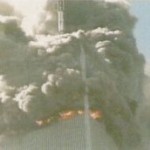 many people died, but still we watched as they dug through the rubble. We thought there would suddenly be people found alive in that rubble. As time went on, we knew that there wouldn’t be huge numbers of survivors. In the end, only twelve people were found alive after the towers fell. After a couple of days, we knew there would be no more, still we could not look away. We had to watch…had to know. As each lost one was found…we cried right along with their families. Then came the worst horror of all…finding out that some people would never be found. The fires had been so hot that their bodies were cremated. That added more horror to our thoughts. It was something we just couldn’t fathom, just like we could not fathom that 15 years later, that day would still be as vivid in our memories as it was on the day we were attacked.
many people died, but still we watched as they dug through the rubble. We thought there would suddenly be people found alive in that rubble. As time went on, we knew that there wouldn’t be huge numbers of survivors. In the end, only twelve people were found alive after the towers fell. After a couple of days, we knew there would be no more, still we could not look away. We had to watch…had to know. As each lost one was found…we cried right along with their families. Then came the worst horror of all…finding out that some people would never be found. The fires had been so hot that their bodies were cremated. That added more horror to our thoughts. It was something we just couldn’t fathom, just like we could not fathom that 15 years later, that day would still be as vivid in our memories as it was on the day we were attacked.
 Inspiration comes from many different places, but most often from an event that so strongly affects our emotions or our lives, that we feel the need to act. That is what happened to a number of students who all had something in common…Christa McAuliffe. On this day, January 28, 1986…30 years ago, after months of training and a huge national following, Christa McAuliffe entered the Space Shuttle Challenger, and went down in history as not only the first teacher chosen to go into space, but the first civilian to die on such a mission. She never made it into space, because just 73 seconds after the launch, the Challenger exploded.
Inspiration comes from many different places, but most often from an event that so strongly affects our emotions or our lives, that we feel the need to act. That is what happened to a number of students who all had something in common…Christa McAuliffe. On this day, January 28, 1986…30 years ago, after months of training and a huge national following, Christa McAuliffe entered the Space Shuttle Challenger, and went down in history as not only the first teacher chosen to go into space, but the first civilian to die on such a mission. She never made it into space, because just 73 seconds after the launch, the Challenger exploded.
The world looked on in horror, because this launch had been so widely televised and so greatly anticipated.  After the explosion, the news was broadcast over and over. We saw the horrified faces of the families of the crew, the tears of family, friends, and students of the first teacher in space, and we saw the explosion…over and over again. The heart of a nation was broken, not just because of Christa McAuliffe, but also for the families of payload specialist Gregory Jarvis; and astronauts Judith A. Resnik, mission specialist; Francis R. (Dick) Scobee, mission commander; Ronald E. McNair, mission specialist; Mike J. Smith, pilot; and Ellison S. Onizuka, mission specialist. It had been many years since the NASA space program had lost a crew, and it was the first one in flight.
After the explosion, the news was broadcast over and over. We saw the horrified faces of the families of the crew, the tears of family, friends, and students of the first teacher in space, and we saw the explosion…over and over again. The heart of a nation was broken, not just because of Christa McAuliffe, but also for the families of payload specialist Gregory Jarvis; and astronauts Judith A. Resnik, mission specialist; Francis R. (Dick) Scobee, mission commander; Ronald E. McNair, mission specialist; Mike J. Smith, pilot; and Ellison S. Onizuka, mission specialist. It had been many years since the NASA space program had lost a crew, and it was the first one in flight.
I’m sure that an accident in space did not inspire people to go into the space program, because the safety of the program immediately came into question. Nevertheless, from this tragedy…from out of the ashes of the Space Shuttle Challenger, inspiration did come. It came in the form of teachers. The students of Christa  McAuliffe…not all, but a number of them, were inspired to become teachers themselves. Each of those former students of Christa McAuliffe…kids who maybe didn’t like social studies, but because Christa McAuliffe made it interesting somehow, they did well in her class, and were inspired by her. After her passing, these inspired students decided that they wanted to pick up where she left off. They wanted to carry on with her dream. They follow her motto, “I touch the future. I teach.” One of those teachers commented that she heard people say that and wondered if they had any idea where that motto came from. Her former students knew…it was Christa McAuliffe, and her legacy lives on, 30 years after her death.
McAuliffe…not all, but a number of them, were inspired to become teachers themselves. Each of those former students of Christa McAuliffe…kids who maybe didn’t like social studies, but because Christa McAuliffe made it interesting somehow, they did well in her class, and were inspired by her. After her passing, these inspired students decided that they wanted to pick up where she left off. They wanted to carry on with her dream. They follow her motto, “I touch the future. I teach.” One of those teachers commented that she heard people say that and wondered if they had any idea where that motto came from. Her former students knew…it was Christa McAuliffe, and her legacy lives on, 30 years after her death.
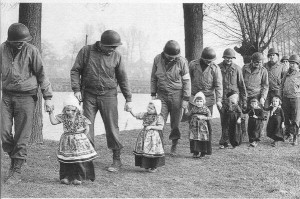
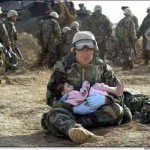 When we think of soldiers, most of us picture the fighting machines that these men have been trained to be, and we would not be wrong in most respects, but what we sometimes fail to realize is the fact that a soldier is a person with a deep love of human life. They don’t go to war because they want to be trained killers, but rather they go to war because they want to preserve life, and a way of life. They see that there are people in this world who are being abused, beaten, and starved into submission…or worse yet killed for refusing to submit. There are evil people in this world, who somehow feel that they have the right to control other human lives. They want servants, or they want to sell people, or just own people. Soldiers go to war, because they see these evil actions for the wrong that they are, and they can’t stand by and let it just happen.
When we think of soldiers, most of us picture the fighting machines that these men have been trained to be, and we would not be wrong in most respects, but what we sometimes fail to realize is the fact that a soldier is a person with a deep love of human life. They don’t go to war because they want to be trained killers, but rather they go to war because they want to preserve life, and a way of life. They see that there are people in this world who are being abused, beaten, and starved into submission…or worse yet killed for refusing to submit. There are evil people in this world, who somehow feel that they have the right to control other human lives. They want servants, or they want to sell people, or just own people. Soldiers go to war, because they see these evil actions for the wrong that they are, and they can’t stand by and let it just happen.
So yes, in that respect, our picture of the trained killer is exactly right, but what we so often miss is the human side of the soldier. We miss the man or woman who has left their own children, nieces, or nephews behind to go and fight for children in some other country, so that they might be able to live out their lives in the same safety that the children, nieces, and nephews of the soldier are able to live in back home. The problem is that we don’t often realize what things they do for those children in other nations. We don’t often see the moments of playing with the children. We don’t see the children who come up to the soldiers, because they feel safe around them…even with the possibility of gunfire at any moment. They still feel safer near the soldiers than they do on their own.
And for our soldiers, who are so lonely for their own children, nieces and nephews, it is a nice break from the reality of war, with all its ugliness, even if it is just once in a while, and even if it is just for a few moments. Maybe they can take a few moments and pretend that this child they are playing with is their own child at home. Maybe they can pretend that they are pushing their own child in a swing, on a merry-go-round, or just giving them a simple hug. Perhaps those few moments that they get once in a while, can take them away from 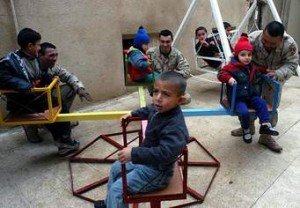
 the worry for their own safety, or the fact that in a little while they will be faced with an enemy, who they will have to kill, or they will be killed. War is a hard place to be, and a life event that no soldier can ever forget, so it is nice, for just a few moments, to be able to spend a little time with a child, to get away from the war and the ugliness that lies within it. Sometimes we, the people back home need to just consider the sacrifice our soldiers make, and be glad that they have a moment of relief, even if it is just once in a while.
the worry for their own safety, or the fact that in a little while they will be faced with an enemy, who they will have to kill, or they will be killed. War is a hard place to be, and a life event that no soldier can ever forget, so it is nice, for just a few moments, to be able to spend a little time with a child, to get away from the war and the ugliness that lies within it. Sometimes we, the people back home need to just consider the sacrifice our soldiers make, and be glad that they have a moment of relief, even if it is just once in a while.
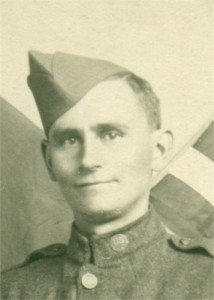 Many members of my family have fought in the many wars that have taken place in this world’s history…most of them I probably know nothing about. Wars, while usually necessary in order keep our nation secure; take a heavy toll on its youth. Of course, in years gone by, women were not placed in combat positions. That is no longer the case. Now women are among those war dead, just like men are.
Many members of my family have fought in the many wars that have taken place in this world’s history…most of them I probably know nothing about. Wars, while usually necessary in order keep our nation secure; take a heavy toll on its youth. Of course, in years gone by, women were not placed in combat positions. That is no longer the case. Now women are among those war dead, just like men are.
The weapons of warfare have become more and more deadly over the years, but I can’t say that there were more war dead because of that. War dead numbers seem to fluctuate with the war, and with the willingness to die, on the part of both sides. Sometimes however, something is invented, and then improved to save lives. Such was the case with the tank. On September 6, 1915, the tank, nicknamed Little Willie rolled off of the assembly line in England. That first tank was less than well received. It was slow…maxing out at 2 miles per hour. It weighed 14 tons, and kept getting stuck in the trenches. Nevertheless, it was important, since wars had moved into that type of fighting. Trench warfare often made soldiers sitting ducks…both the ones in the trenches, and the ones coming up on the trenches. The plan was to make a vehicle that could go cross country, and into the trenches with relative safety.
I’m sure the designers were very disappointed, but they didn’t give up. They went to work to improve this valuable piece of military equipment. The next model…Big Willie debuted a year later, and while it still needed improving, people could now see how important the vehicle would become in response to the trench warfare of World War I. The tank was in existence when my grandfather was drafted into World War I, but I don’t know if he ever had the opportunity to see one or ride in one. I can’t say if the tank changed the way that World War I was going, but it has definitely made a difference in the wars since that time.
The tank has come a long way since those days…including the name. It was never in the plan to call this piece of equipment a tank. They had planned to make a landboat, and organized a Landships Committee to begin development. It was vital that they keep the vehicle a secret from enemies, so workers were apparently told that they were building a machine to carry water on the battlefield. Some say that the tank resembled water tanks. Whatever the case may be, the new vehicles were shipped in crates labeled “tank” and the name stuck.
